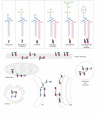The complex life of simple sphingolipids
- PMID: 15289826
- PMCID: PMC1299119
- DOI: 10.1038/sj.embor.7400208
The complex life of simple sphingolipids
Abstract
The extensive diversity of membrane lipids is rarely appreciated by cell and molecular biologists. Although most researchers are familiar with the three main classes of lipids in animal cell membranes, few realize the enormous combinatorial structural diversity that exists within each lipid class, a diversity that enables functional specialization of lipids. In this brief review, we focus on one class of membrane lipids, the sphingolipids, which until not long ago were thought by many to be little more than structural components of biological membranes. Recent studies have placed sphingolipids-including ceramide, sphingosine and sphingosine-1-phosphate-at the centre of a number of important biological processes, specifically in signal transduction pathways, in which their levels change in a highly regulated temporal and spatial manner. We outline exciting progress in the biochemistry and cell biology of sphingolipids and focus on their functional diversity. This should set the conceptual and experimental framework that will eventually lead to a fully integrated and comprehensive model of the functions of specific sphingolipids in regulating defined aspects of cell physiology.
Figures




References
-
- Alberts B, Johnson A, Lewis J, Raff M, Roberts K, Walter P (2002) Molecular Biology of the Cell. Garland Science, New York, USA.
-
- Alvarez-Vasquez F, Sims KJ, Hannun YA, Voit EO (2004) Integration of kinetic information on yeast sphingolipid metabolism in dynamical pathway models. J Theor Biol 226: 265–291 - PubMed
-
- Brugger B, Graham C, Leibrecht I, Mombelli E, Jen A, Wieland F, Morris R (2004) The membrane domains occupied by glycosylphosphatidylinositol-anchored prion protein and Thy-1 differ in lipid composition. J Biol Chem 279: 7530–7536 - PubMed
Publication types
MeSH terms
Substances
Grants and funding
LinkOut - more resources
Full Text Sources
Other Literature Sources

